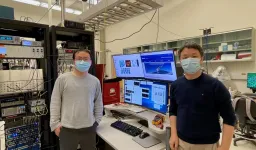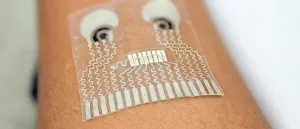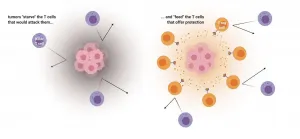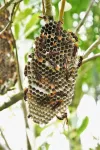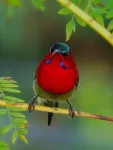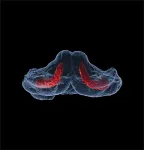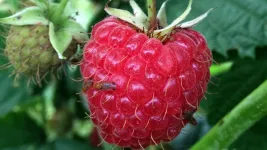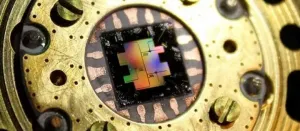(Press-News.org) RIVERSIDE, Calif. -- Materials having excess electrons are typically conductors. However, moiré patterns -- interference patterns that typically arise when one object with a repetitive pattern is placed over another with a similar pattern -- can suppress electrical conductivity, a study led by physicists at the University of California, Riverside, has found.
In the lab, the researchers overlaid a single monolayer of tungsten disulfide (WS2) on a single monolayer of tungsten diselenide (WSe2) and aligned the two layers against each other to generate large-scale moiré patterns. The atoms in both the WS2 and WSe2 layers are arranged in a two-dimensional honeycomb lattice with a periodicity, or recurring intervals, of much less than 1 nanometer. But when the two lattices are aligned at 0 or 60 degrees, the composite material generates a moiré pattern with a much larger periodicity of about 8 nanometers. The conductivity of this 2D system depends on how many electrons are placed in the moiré pattern.
"We found that when the moiré pattern is partially filled with electrons, the system exhibits several insulating states as opposed to conductive states expected from conventional understanding," said Yongtao Cui, an assistant professor of physics and astronomy at UC Riverside, who led the research team. "The filling percentages were found to be simple fractions like 1/2, 1/3, 1/4, 1/6, and so on. The mechanism for such insulating states is the strong interaction among electrons that restricts the mobile electrons into local moiré cells. This understanding may help to develop new ways to control conductivity and to discovery new superconductor materials."
Study results appear today in Nature Physics.
The moiré patterns generated on the composite material of WS2 and WSe2 can be imagined to be with wells and ridges arranged similarly in a honeycomb pattern.
"WS2 and WSe2 have a slight mismatch where lattice size is concerned, making them ideal for producing moiré patterns," Cui said. "Further, coupling between electrons becomes strong, meaning the electrons 'talk to each other' while moving around across the ridges and the wells."
Typically, when a small number of electrons are placed in a 2D layer such as WS2 or WSe2, they have enough energy to travel freely and randomly, making the system a conductor. Cui's lab found that when moiré lattices are formed using both WS2 and WSe2, resulting in a periodic pattern, the electrons begin to slow down and repel from each other.
"The electrons do not want to stay close to each other," said Xiong Huang, the first author of the paper and a doctoral graduate student in Cui's Microwave Nano-Electronics Lab. "When the number of electrons is such that one electron occupies every moiré hexagon, the electrons stay locked in place and cannot move freely anymore. The system then behaves like an insulator."
Cui likened the behavior of such electrons to social distancing during a pandemic.
"If the hexagons can be imagined to be homes, all the electrons are indoors, one per home, and not moving about in the neighborhood," he said. "If we don't have one electron per hexagon, but instead have 95% occupancy of hexagons, meaning some nearby hexagons are empty, then the electrons can still move around a little through the empty cells. That's when the material is not an insulator. It behaves like a poor conductor."
His lab was able to fine-tune the number of electrons in the WS2- WSe2 lattice composite in order to change the average occupancy of the hexagons. His team found insulating states occurred when average occupancy was less than one. For example, for an occupancy of one-third, the electrons occupied every other hexagon.
"Using the social distancing analogy, instead of a separation of 6 feet, you now have a separation of, say, 10 feet," Cui said. "Thus, when one electron occupies a hexagon, it forces all neighboring hexagons to be empty in order to comply with the stricter social distancing rule. When all electrons follow this rule, they form a new pattern and occupy one third of the total hexagons in which they again lose the freedom to move about, leading to an insulating state."
The study shows similar behaviors can also occur for other occupancy fractions such as 1/4, 1/2, and 1/6, with each corresponding to a different occupation pattern.
Cui explained that these insulating states are caused by strong interactions between the electrons. This, he added, is the Coulomb repulsion, the repulsive force between two positive or two negative charges, as described by the Coulomb's law.
He added that in 3D materials, strong electron interactions are known to give rise to various exotic electronic phases. For example, they likely contribute to the formation of unconventional high temperature superconductivity.
"The question we still have no answer for is whether 2D structures, the kind we used in our experiments, can produce high temperature superconductivity," Cui said.
Next, his group will work on characterizing the strength of the electron interactions.
"The interaction strength of the electrons largely determines the insulation state of the system," Cui said. "We are also interested in being able to manipulate the strength of the electron interaction."
Cui and Huang were funded by grants from the National Science Foundation, a Hellman Fellowship, and a seed grant from SHINES.
INFORMATION:
They were joined in the research by Tianmeng Wang, Shengnan Miao, Zhipeng Li, Zhen Lian and Su-Fei Shi at Rensselaer Polytechnic Institute in New York; Chong Wang and Di Xiao at Carnegie Mellon University in Pennsylvania; Takashi Taniguchi and Kenji Watanabe at the National Institute for Materials Science in Japan; and Satoshi Okamoto at Oak Ridge National Laboratory in Tennessee. Huang, T. Wang, Miao, and C. Wang contribute equally to the study.
The research paper is titled "Correlated Insulating States at Fractional Fillings of the WS2/ WSe2 Moire? Lattice."
The University of California, Riverside (http://www.ucr.edu) is a doctoral research university, a living laboratory for groundbreaking exploration of issues critical to Inland Southern California, the state and communities around the world. Reflecting California's diverse culture, UCR's enrollment is more than 25,000 students. The campus opened a medical school in 2013 and has reached the heart of the Coachella Valley by way of the UCR Palm Desert Center. The campus has an annual statewide economic impact of almost $2 billion. To learn more, email news@ucr.edu.
Engineers at the University of California San Diego have developed a soft, stretchy skin patch that can be worn on the neck to continuously track blood pressure and heart rate while measuring the wearer's levels of glucose as well as lactate, alcohol or caffeine. It is the first wearable device that monitors cardiovascular signals and multiple biochemical levels in the human body at the same time.
"This type of wearable would be very helpful for people with underlying medical conditions to monitor their own health on a regular basis," said Lu Yin, a nanoengineering Ph.D. student at UC San Diego and co-first author of the study published Feb. 15 in Nature Biomedical Engineering. "It would also serve as a great tool for remote patient monitoring, ...
PITTSBURGH, Feb. 15, 2021 - A paper published today in Nature shows how chemicals in the areas surrounding tumors--known as the tumor microenvironment--subvert the immune system and enable cancer to evade attack. These findings suggest that an existing drug could boost cancer immunotherapy.
The study was conducted by a team of scientists at UPMC Hillman Cancer Center and the University of Pittsburgh School of Medicine, led by Greg Delgoffe, Ph.D., Pitt associate professor of immunology. By disrupting the effect of the tumor microenvironment on immune cells in mice, the researchers were able to shrink tumors, prolong survival and increase sensitivity to immunotherapy.
"The majority of people don't respond to immunotherapy," said Delgoffe. "The reason ...
Researchers have found a way to use light and a single electron to communicate with a cloud of quantum bits and sense their behaviour, making it possible to detect a single quantum bit in a dense cloud.
The researchers, from the University of Cambridge, were able to inject a 'needle' of highly fragile quantum information in a 'haystack' of 100,000 nuclei. Using lasers to control an electron, the researchers could then use that electron to control the behaviour of the haystack, making it easier to find the needle. They were able to detect the 'needle' with a precision of 1.9 parts per million: high enough to detect a single quantum bit in this large ensemble.
The technique makes it possible to send highly fragile ...
[Images and video available: see notes to editors]
Wasps provide crucial support to their extended families by babysitting at neighbouring nests, according to new research by a team of biologists from the universities of Bristol, Exeter and UCL published today [15 February] in Nature Ecology and Evolution.
The findings suggest that animals should often seek to help more distant relatives if their closest kin are less in need.
Dr Patrick Kennedy, lead author and Marie Curie research fellow in the School of Biological Sciences at the University of Bristol, said: "These wasps can act like rich family members lending a hand to their second cousins. If there's not much more you can do to help your immediate family, you can ...
Feathers are a sleek, intricate evolutionary innovation that makes flight possible for birds, but in addition to their stiff, aerodynamic feathers used for flight, birds also keep a layer of soft, fluffy down feathers between their bodies and their outermost feathers to regulate body temperature.
Using the Smithsonian's collection of 625,000 bird specimens, Sahas Barve, a Peter Buck Fellow at the Smithsonian's National Museum of Natural History, led a new study to examine feathers across 249 species of Himalayan songbirds, finding that birds living at higher elevations have more of the fluffy down--the type of feathers humans stuff their jackets with--than birds from lower elevations. Published ...
Ciliopathies are genetic disorders caused by defects in the structure and function of cilia, microtubule-based organelles present on the surface of almost every cell in the human body which play crucial roles in cell signalling. Ciliopathies present a wide range of often severe clinical symptoms, frequently affecting the head and face and leading to conditions such as cleft palate and micrognathia (an underdeveloped lower jaw that can impair feeding and breathing). While we understand many of the genetic causes of human ciliopathies, they are only half the story: the question remains as to why, at a cellular level, defective cilia cause developmental craniofacial abnormalities. Researchers have now discovered that ciliopathic micrognathia in an animal model results from abnormal skeletal ...
Years of suffering and billions of euro in global health care costs, arising from osteoporosis-related bone fractures, could be eliminated using big data to target vulnerable patients, according to researchers at Lero, the Science Foundation Ireland Research Centre for Software.
A study of 36,590 patients who underwent bone mineral density scans in the West of Ireland between January 2000 and November 2018, found that many fractures are potentially preventable by identifying those at greatest risk before they fracture, and initiating proven, safe, low-cost effective interventions.
The multi-disciplinary study, ...
Long held in a private collection, the newly analysed tooth of an approximately 9-year-old Neanderthal child marks the hominin's southernmost known range. Analysis of the associated archaeological assemblage suggests Neanderthals used Nubian Levallois technology, previously thought to be restricted to Homo sapiens.
With a high concentration of cave sites harbouring evidence of past populations and their behaviour, the Levant is a major centre for human origins research. For over a century, archaeological excavations in the Levant have produced human ...
A recent study finds that the invasive spotted wing drosophila (Drosophila suzukii) prefers to lay its eggs in places that no other spotted wing flies have visited. The finding raises questions about how the flies can tell whether a piece of fruit is virgin territory - and what that might mean for pest control.
D. suzukii is a fruit fly that is native to east Asia, but has spread rapidly across North America, South America, Africa and Europe over the past 10-15 years. The pest species prefers to lay its eggs in ripe fruit, which poses problems for fruit growers, since consumers don't want to buy infested fruit.
To avoid consumer rejection, there are extensive measures in place to avoid infestation, and to prevent infested ...
Aalto researchers have used an IBM quantum computer to explore an overlooked area of physics, and have challenged 100 year old cherished notions about information at the quantum level.
The rules of quantum physics - which govern how very small things behave - use mathematical operators called Hermitian Hamiltonians. Hermitian operators have underpinned quantum physics for nearly 100 years but recently, theorists have realized that it is possible to extend its fundamental equations to making use of Hermitian operators that are not Hermitian. The new equations describe a universe with its own peculiar set of rules: for example, by looking in the ...
